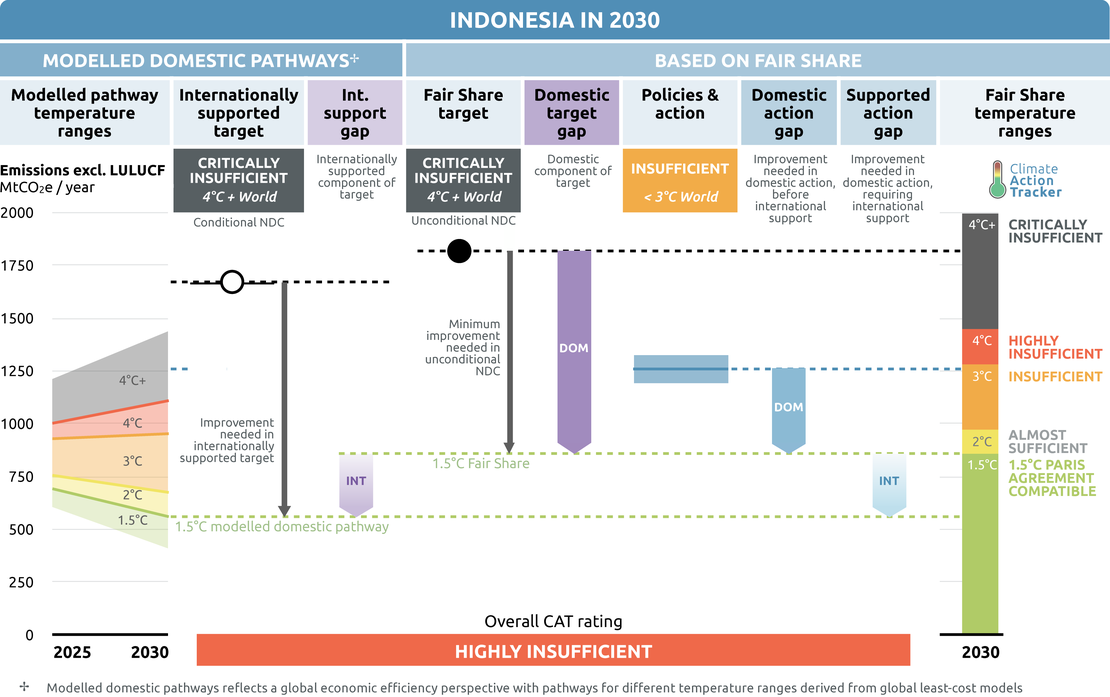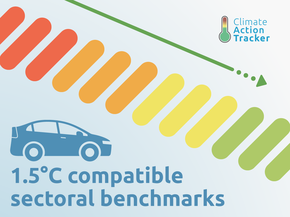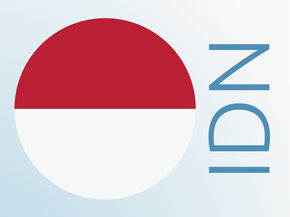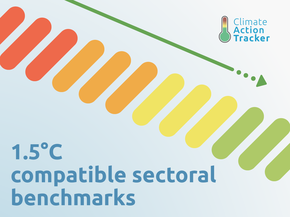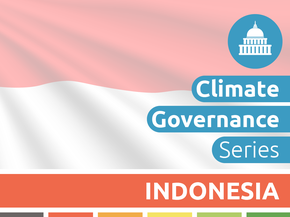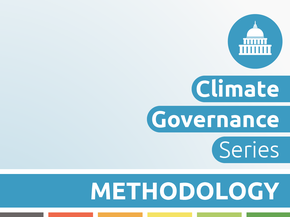Targets
Paris Agreement targets
NDC description
On 22 July 2021, Indonesia submitted its updated NDC, confirming its existing 2030 targets. Indonesia again commits to an unconditional 29% reduction in emissions below a business-as-usual (BAU) scenario, and a conditional 41% reduction in emissions below the same BAU. The updated NDC links to the long-term strategy (LTS), submitted on the same day. Indonesia opens the door to setting a net-zero target, and presents a pathway compatible with doing so by 2060 in its LTS. The country also commits to considering the LTS in the formulation of broader development planning documents and subsequent NDCs.
Indonesia confirms its existing targets in the updated NDC submission. Similar to the previous NDC submission, there were still some inconsistencies between the percentage reduction conditional target and the table presented in the NDC. In August 2021, Indonesia submitted an erratum that corrected these issues.
Indonesia states that the updated NDC is a progression in comparison to the previous one, due to a slight update in the BAU scenario, from 2,881 to 2,869 MtCO2e/year in 2030. However, the BAU presented in the previous NDC was already 2,869 MtCO2e/year in 2030. An absolute emissions target would constitute an improvement on Indonesia’s NDC. Maintaining the same BAU scenario and percentage reduction targets indicate no real progress on the nation’s mitigation objectives.
The NDC relative reductions below BAU may sound ambitious, but a closer look reveals a different picture. The Indonesian NDC projects emissions in the forestry sector to be reduced in comparison to 2010 historical levels, but emissions in the other sectors are still allowed to almost triple by 2030. Therefore, these other sectors will see substantially lower relative reductions below BAU. The absolute emissions levels (excluding forestry) resulting from the unconditional NDC remains at 1,817 MtCO2e/year in 2030, the conditional NDC target leads to 1,661 MtCO2e/year. This means respective relative reductions of 16% and 23% below BAU, excluding forestry.
The CAT rates both Indonesia’s internationally supported target and its fair share target as “Critically insufficient”.
We rate Indonesia’s conditional NDC, excluding the land-use, land-use change and forestry (LULUCF) sector, as “Critically insufficient” when compared to modelled domestic pathways. The “Critically insufficient” rating indicates that Indonesia’s internationally supported target in 2030 reflects minimal to no action and is not at all consistent with the Paris Agreement’s 1.5°C temperature limit. If all countries were to follow Indonesia’s approach, warming would exceed 4°C.
We rate Indonesia’s unconditional NDC, excluding the land-use, land-use change and forestry (LULUCF) sector, as “Critically insufficient”. The “Critically insufficient” rating indicates that Indonesia’s fair share target in 2030 reflects minimal to no action and is not at all consistent with the Paris Agreement’s 1.5°C temperature limit. Indonesia’s target is not in line with any interpretation of a fair approach to meeting the Paris Agreement’s 1.5°C limit. If all countries were to follow Indonesia’s approach, warming would exceed 4°C.
Further information on how the CAT rates countries (against modelled domestic pathways and fair share) can be found here.
The LULUCF sector is a significant source of emissions for Indonesia; however, the CAT fair share and modelled domestic pathways do not consider this sector. For more information click here.
Last NDC update
Indonesia submitted its updated NDC in July 2021, where it did not strengthen the country’s 2030 target. Targets remain unchanged and would lead to emissions significantly above current policies. Even though the targets remain effectively unchanged, the updated NDC does present several improvements in terms of transparency and links with other planning documents.
Maintaining the same level of emission reductions in its NDC update goes against the Paris Agreement, according to which each successive NDC should present a progression beyond the previous one.

Net zero and other long-term target(s)
Indonesia does not have a net zero target.
The Long-term Strategy (LTS) explores scenarios that could lead to net zero by 2060 or sooner but it does not formally commit to a net zero target. The scenarios presented in the LTS will be used to inform future NDC revisions.
In 2015, Indonesia presented a vision for the country in the year of its 100th anniversary (2045) that includes several targets to improve people’s welfare and ensure Indonesia’s development up to 2045. The government recognised that climate change might “pose a hindrance to realising the Indonesian dream in 2045” and developed the LTS in line with the targets presented in Indonesia’s 2045 vision, which includes an emission reduction target of 41% below BAU in 2045.
In March 2019, the Ministry of National Development Planning (BAPPENAS), in collaboration with development partners, released the results of the Low Carbon Development Initiative (LCDI) (Ministry of National Development Planning (BAPPENAS), 2019). The report includes different long-term (2017-2045) emissions pathways together with the policy and development implications of each. These results, together with other modelling exercises, supported the elaboration of Indonesia’s LTS.
Besides presenting a baseline, the LTS puts forward three more ambitious scenarios and compares those to Indonesia’s key climate targets. The scenario compatible with the 2045 vision would also achieve the 2030 NDC conditional target but still result in increasing emissions between 2030 and 2045. The total emissions, incl. LULUCF, would increase by about 30% between today and 2045. The only scenario that would bend emissions downwards would halve total emissions by 2045.
While the CAT does not include LULUCF in its analysis, an increase in emissions up to 2050 is not in line with any “fair” interpretation of a 1.5°C Paris Agreement-compatible pathway.
2020 pledge
In September 2009, the government proposed to cut emissions (incl. LULUCF) by 26% by 2020 from BAU levels and submitted it to the Copenhagen Accord on 30 January 2010. In April 2011, Indonesia clarified that, in addition to its 26% target, it proposed a 41% reduction below BAU target conditional on international support for Nationally Appropriate Mitigation Actions (NAMAs) (Republic of Indonesia, 2011).
Using the BAU and sector contributions as specified in the Second Biennial Update report, the unconditional commitment leads to 1,121 MtCO2e/a in 2020 excl. LULUCF (8% below BAU), and the conditional commitment to 1,089 MtCO2e/a in 2020 excl. LULUCF (11% below BAU). According to the Second Biennial Update Report, about 80% of the reductions for the 2020 target would come from reducing LULUCF emissions (Republic of Indonesia, 2018a).
Further analysis
Country-related publications
Stay informed
Subscribe to our newsletter
